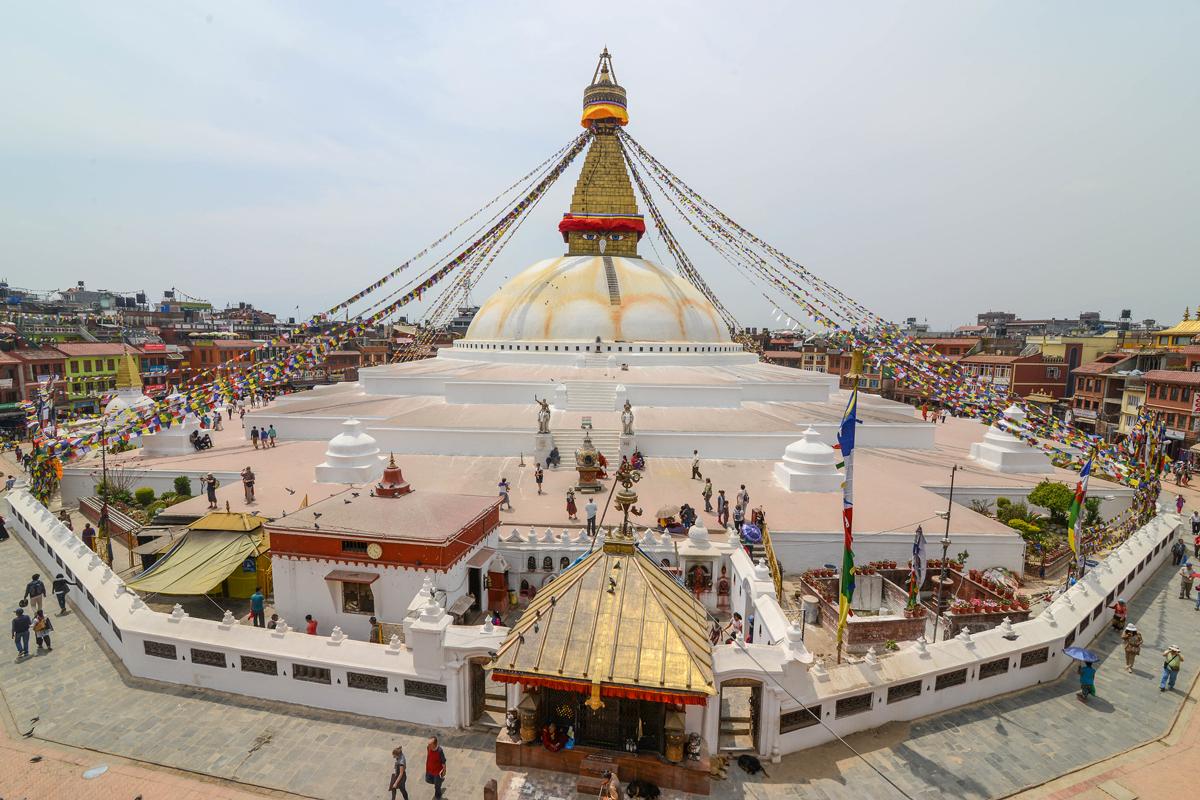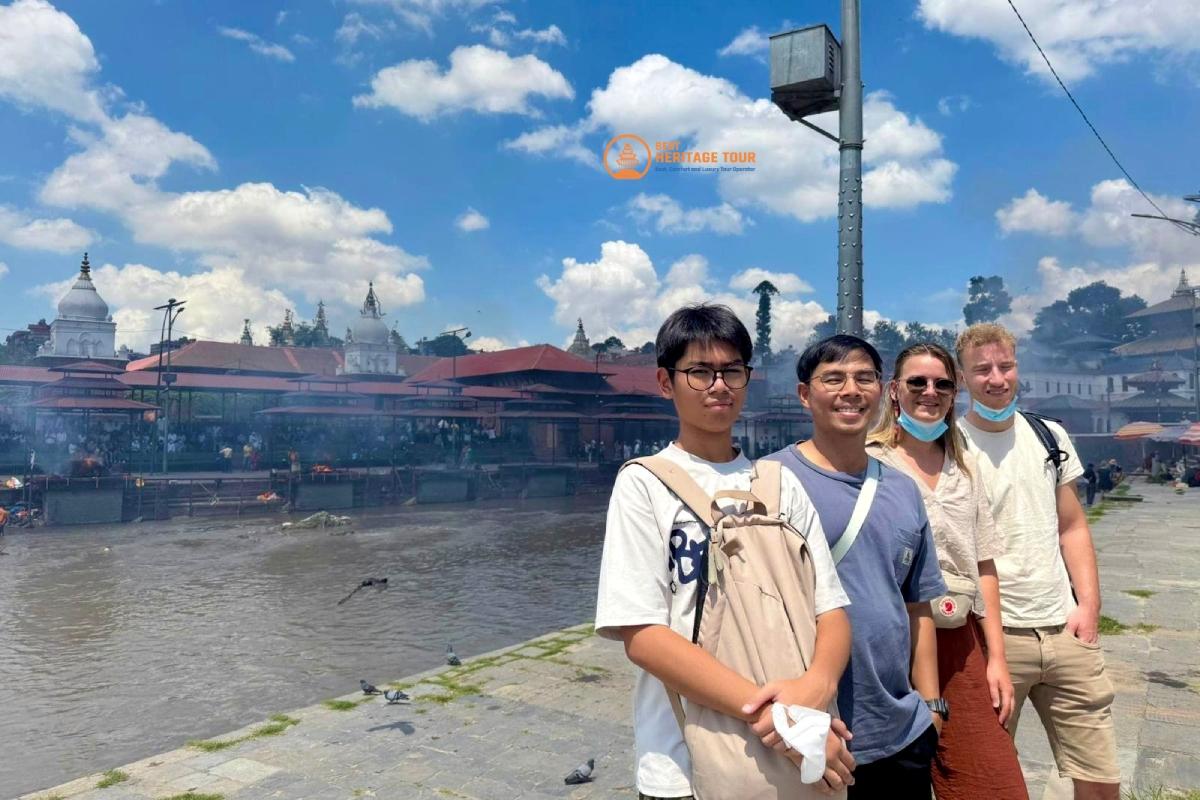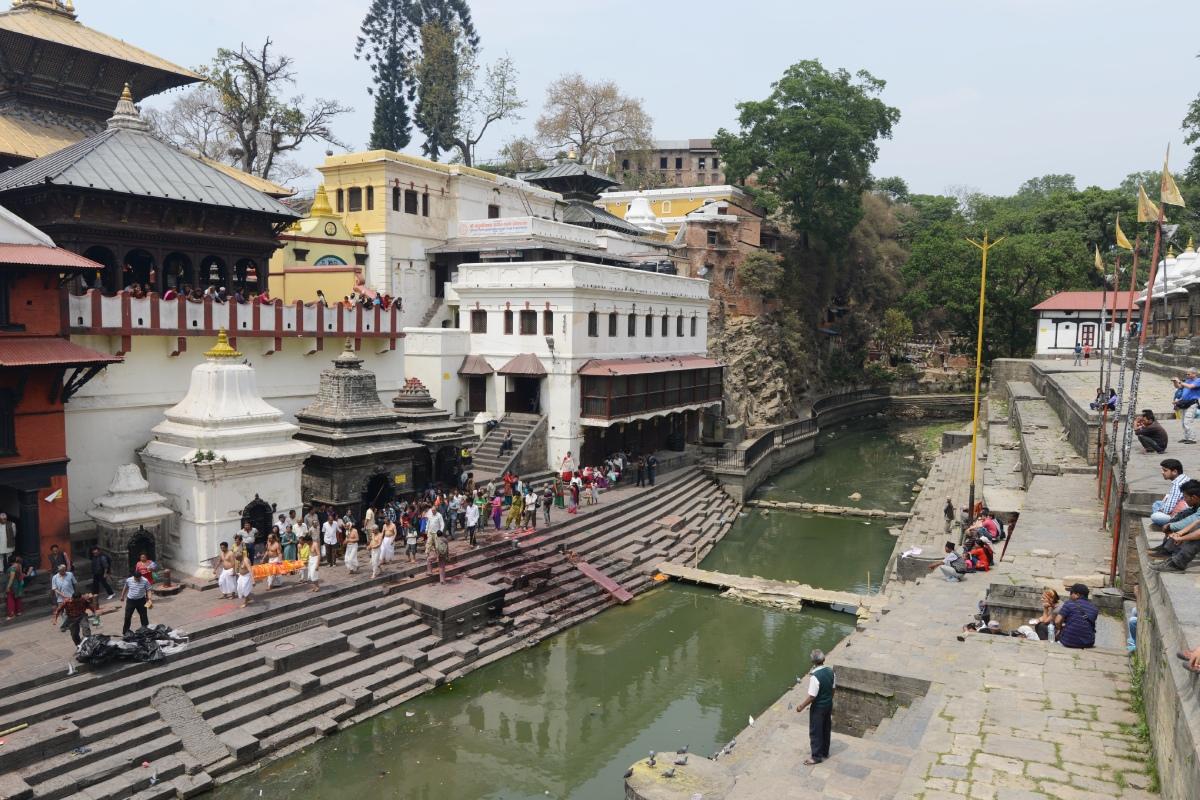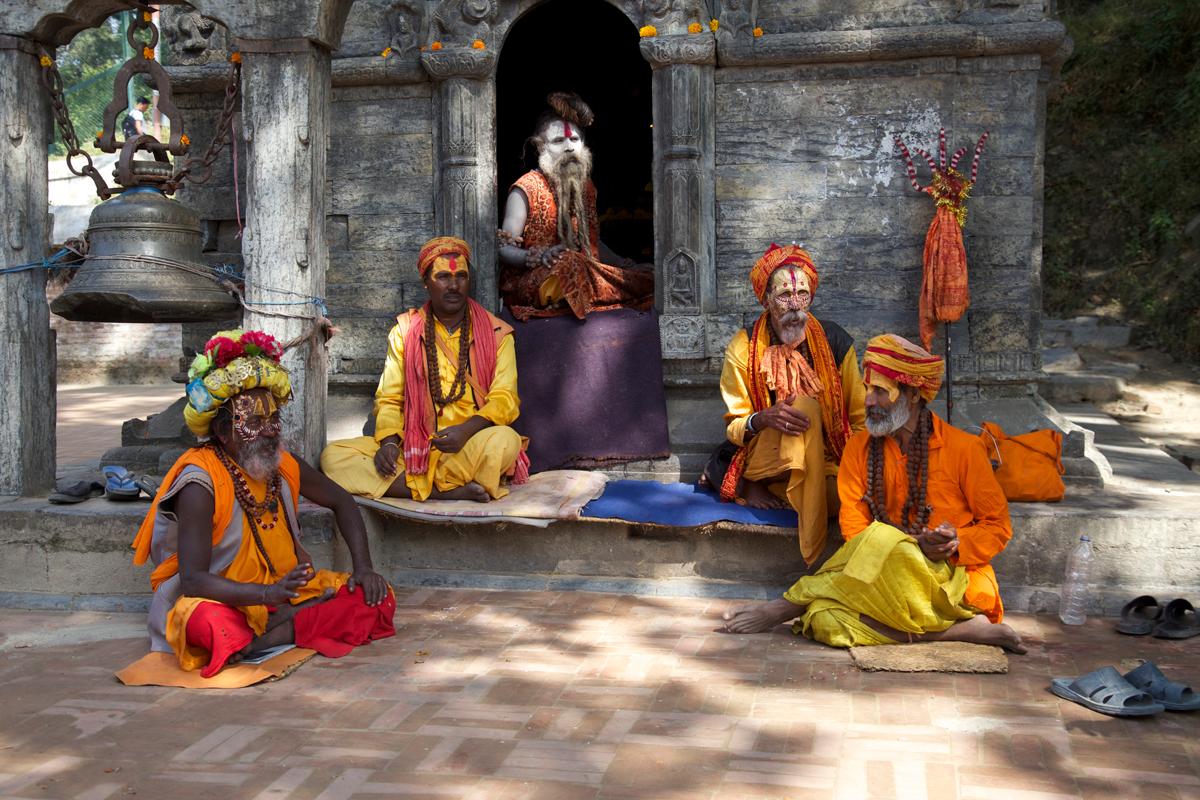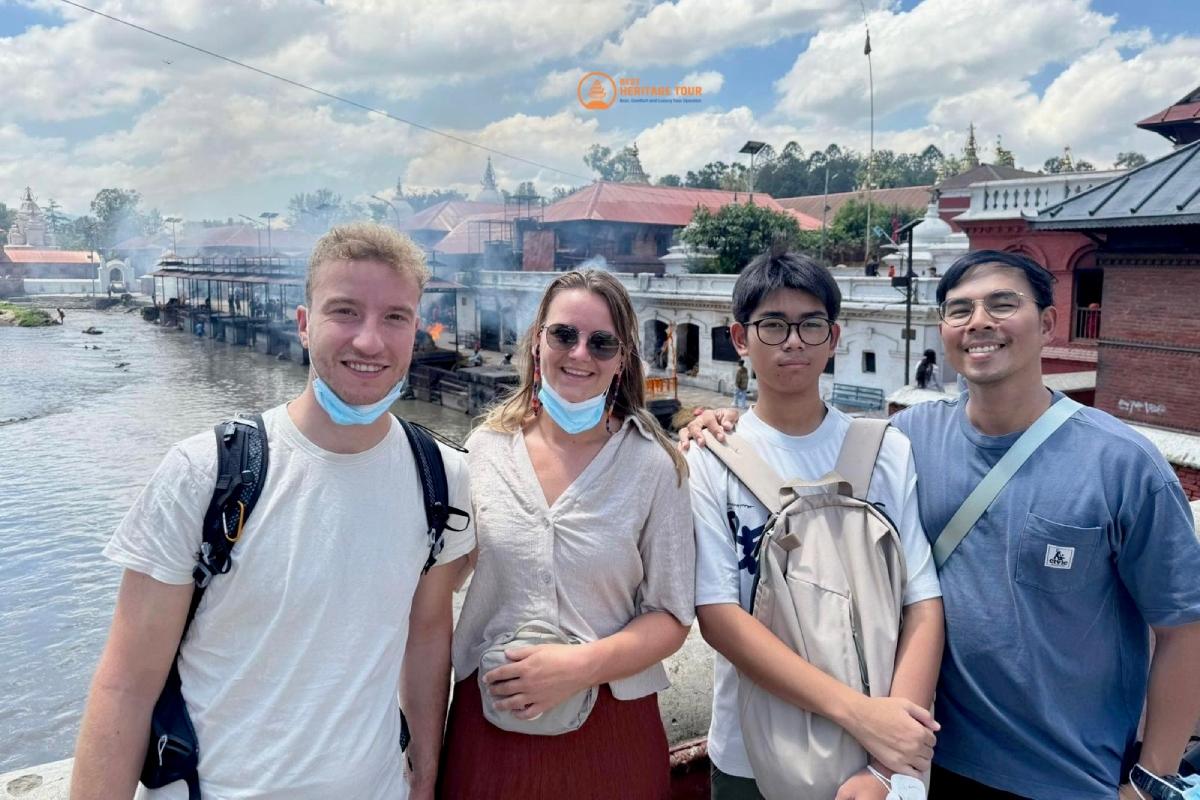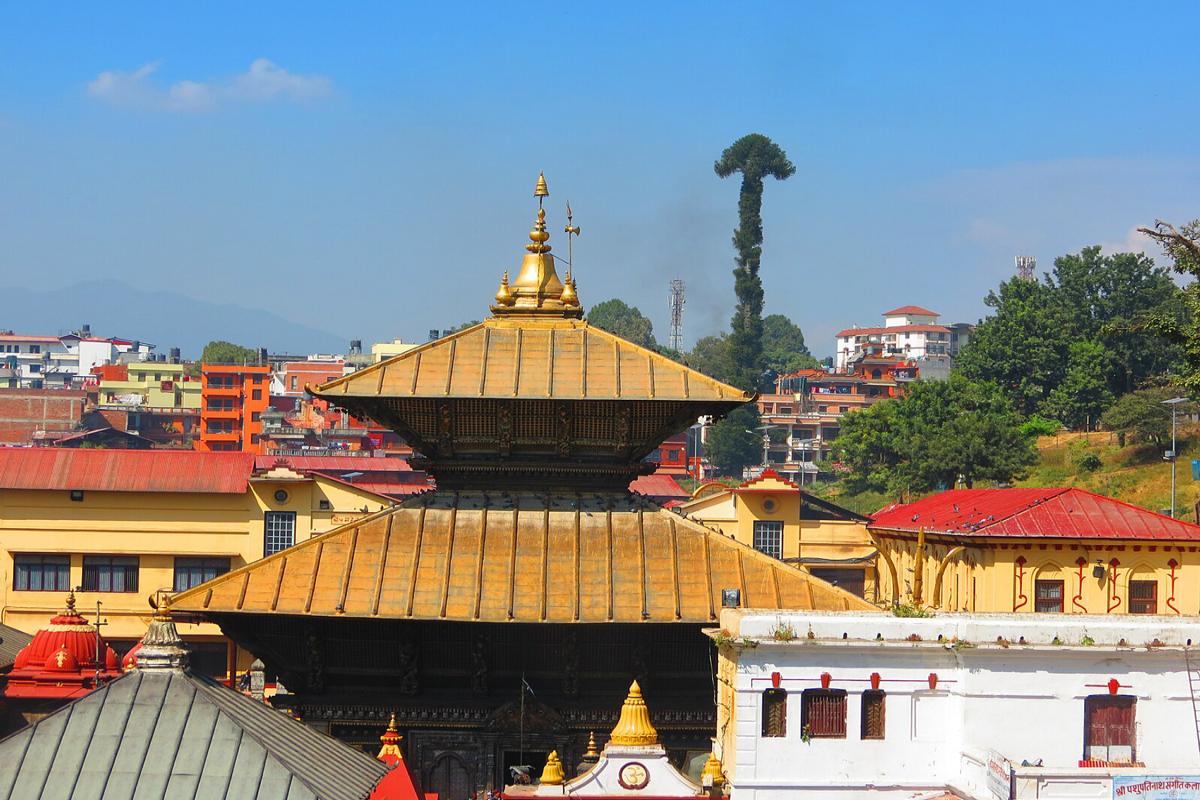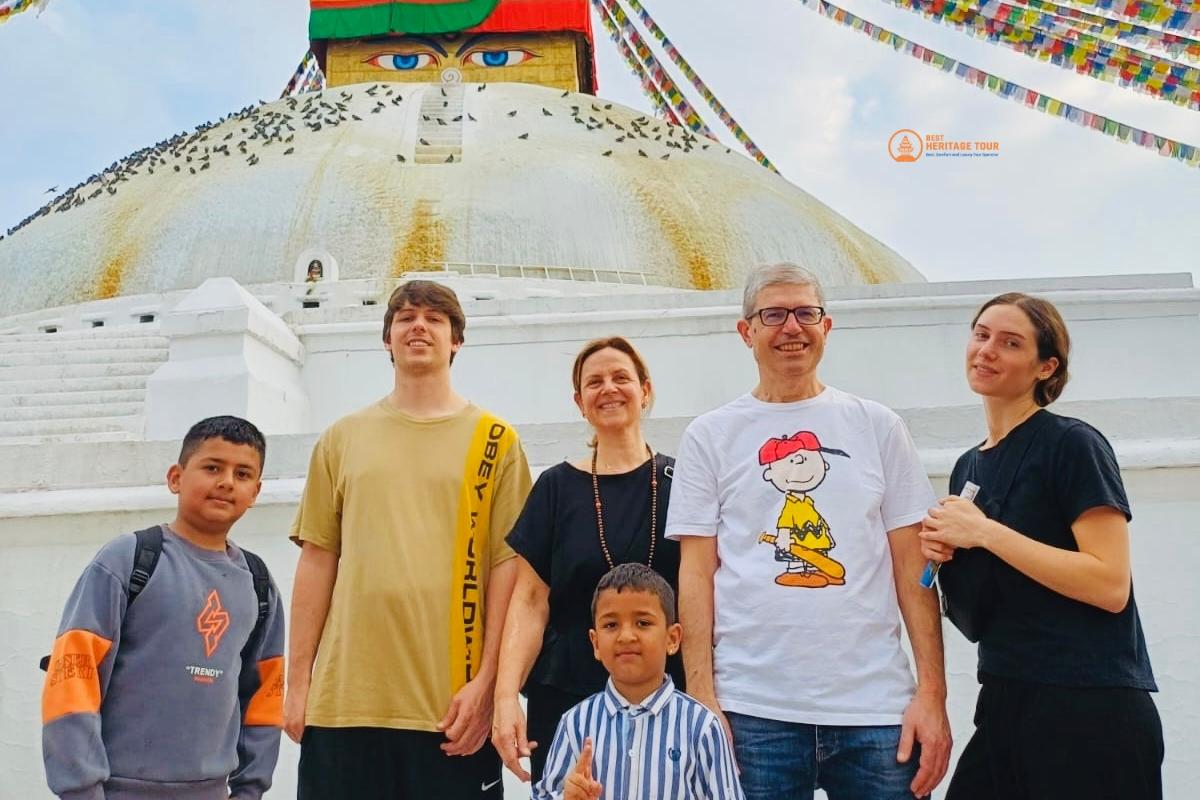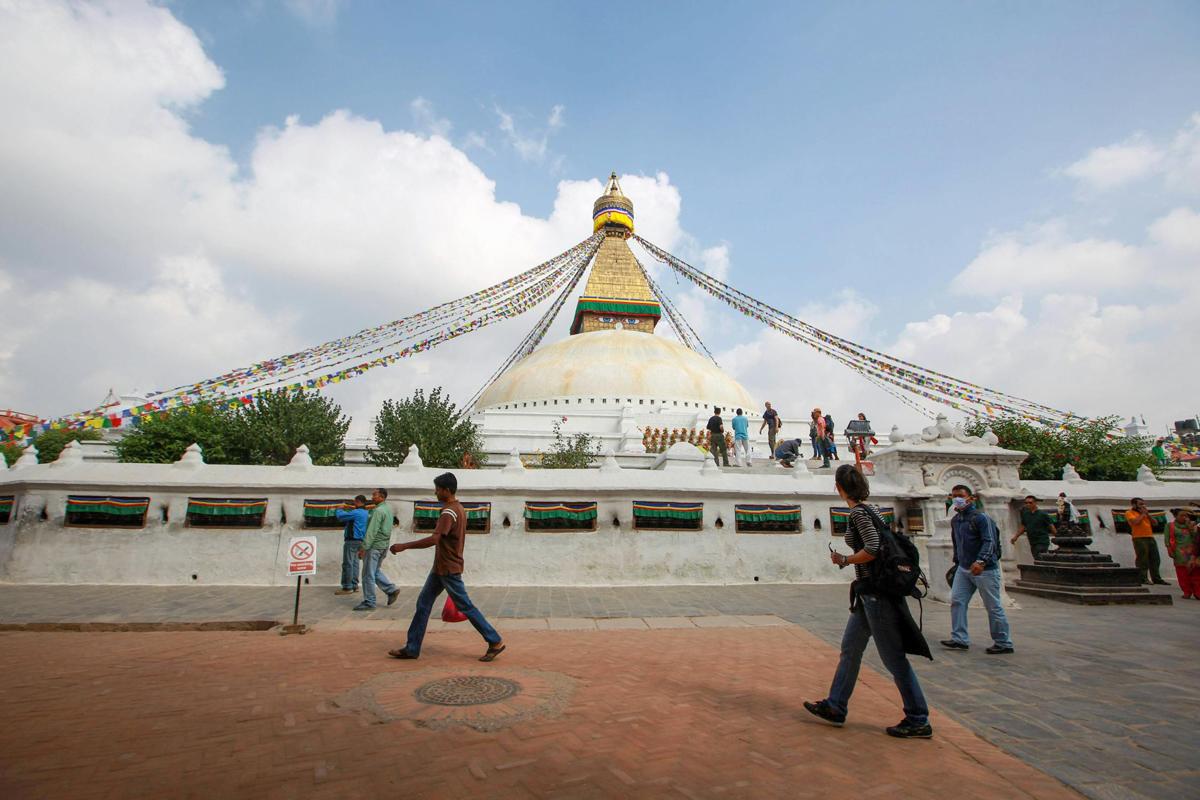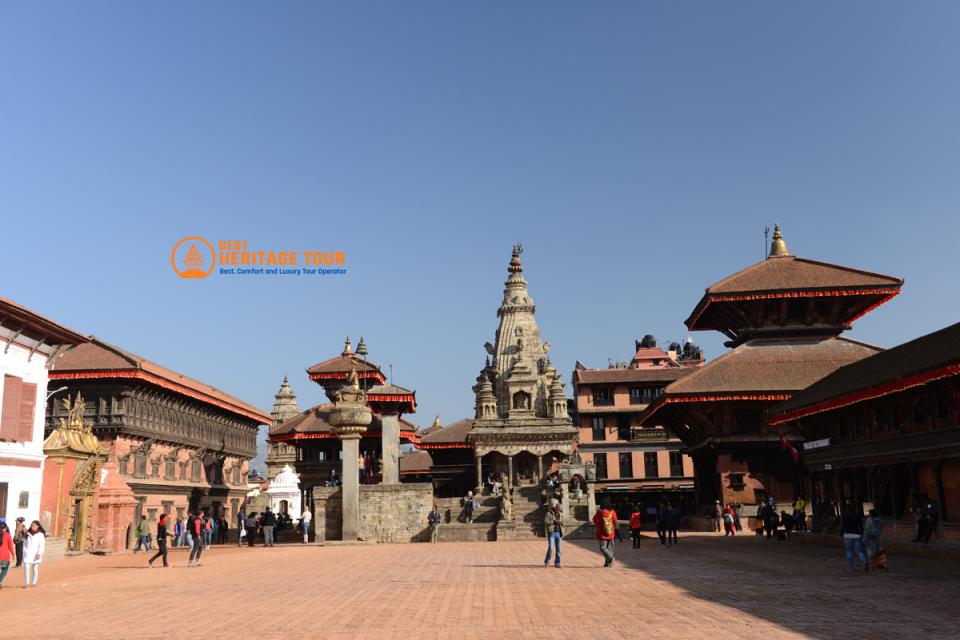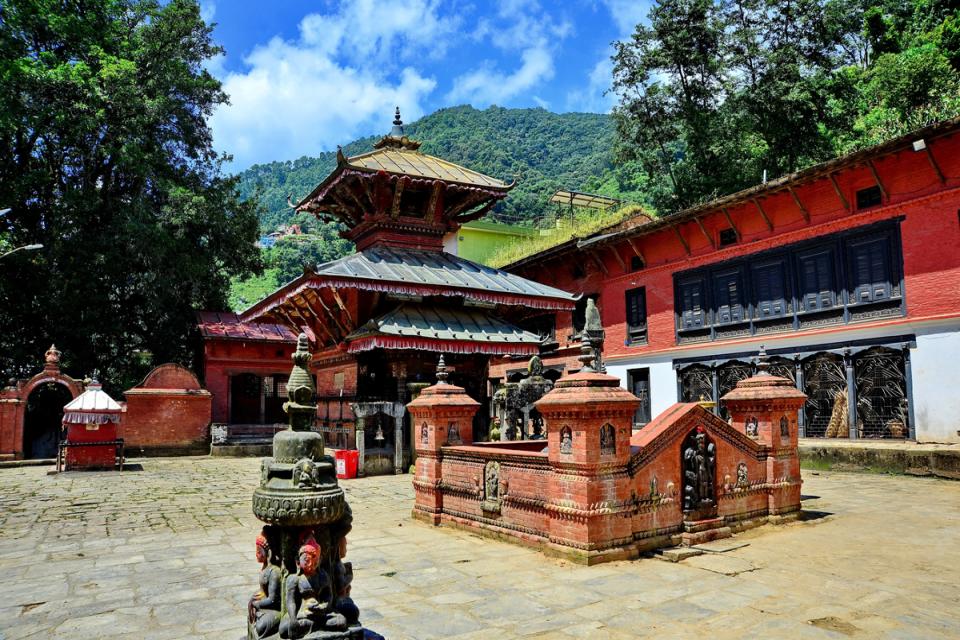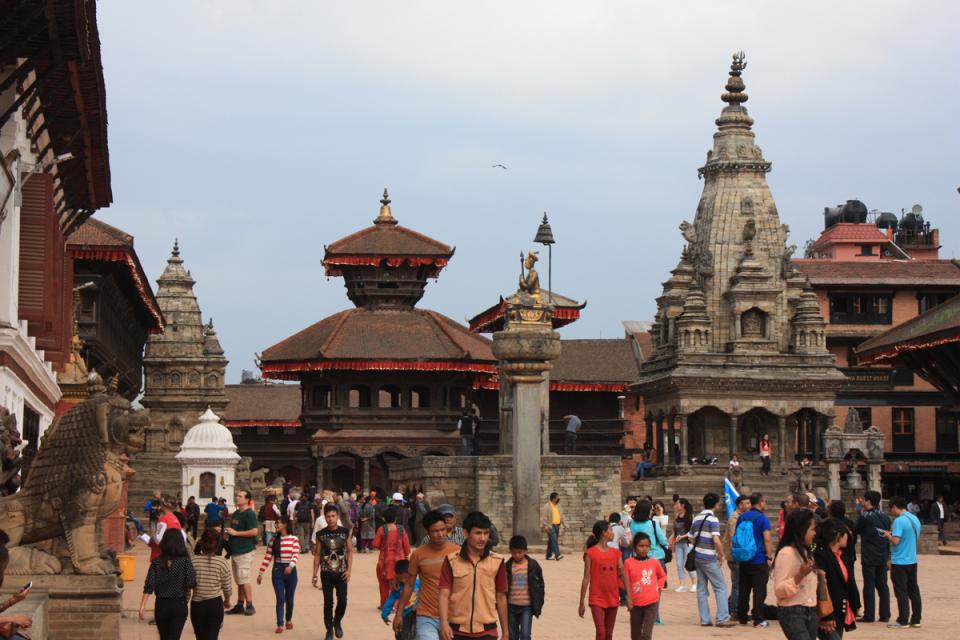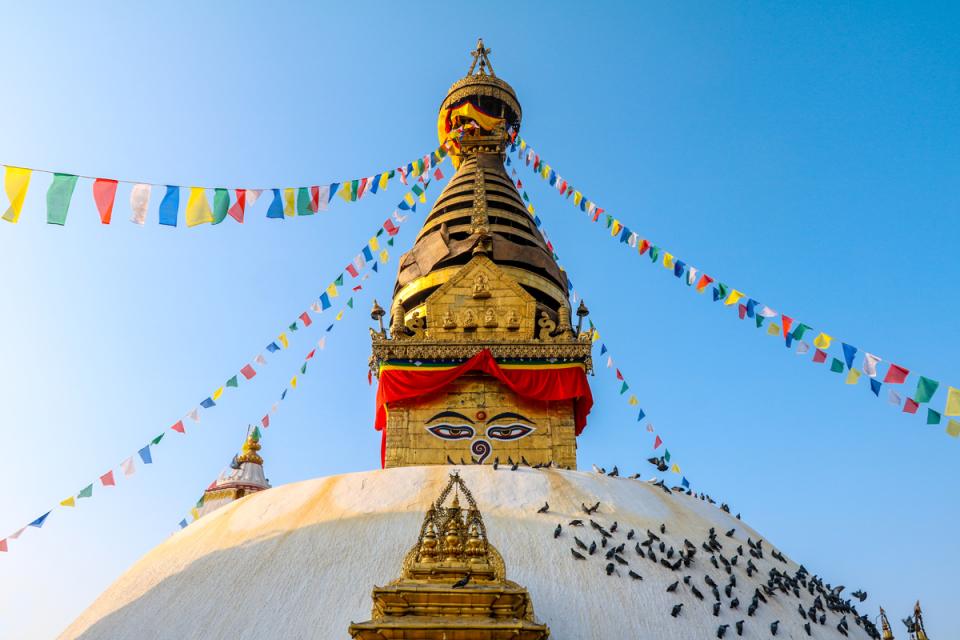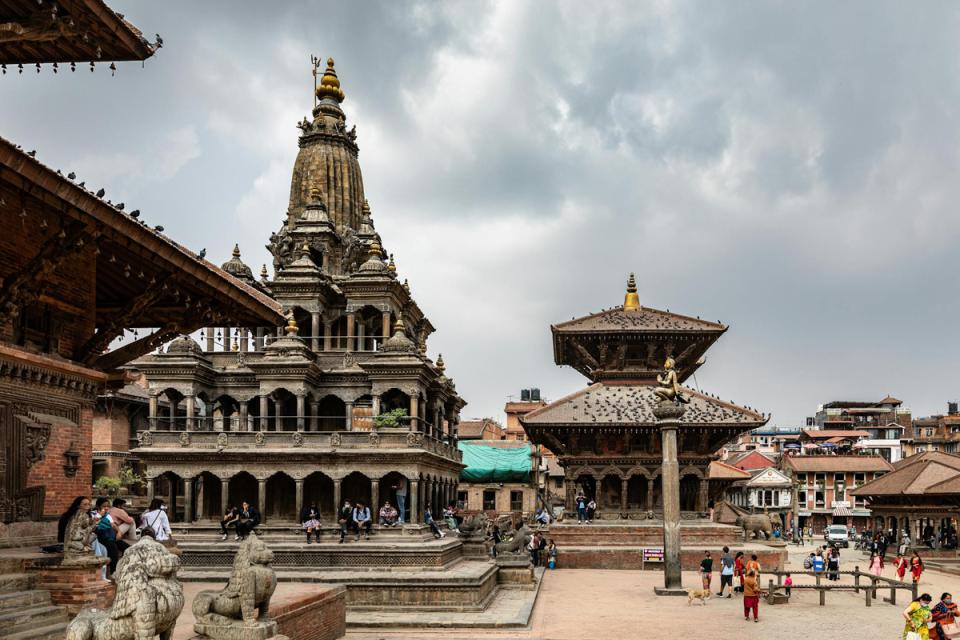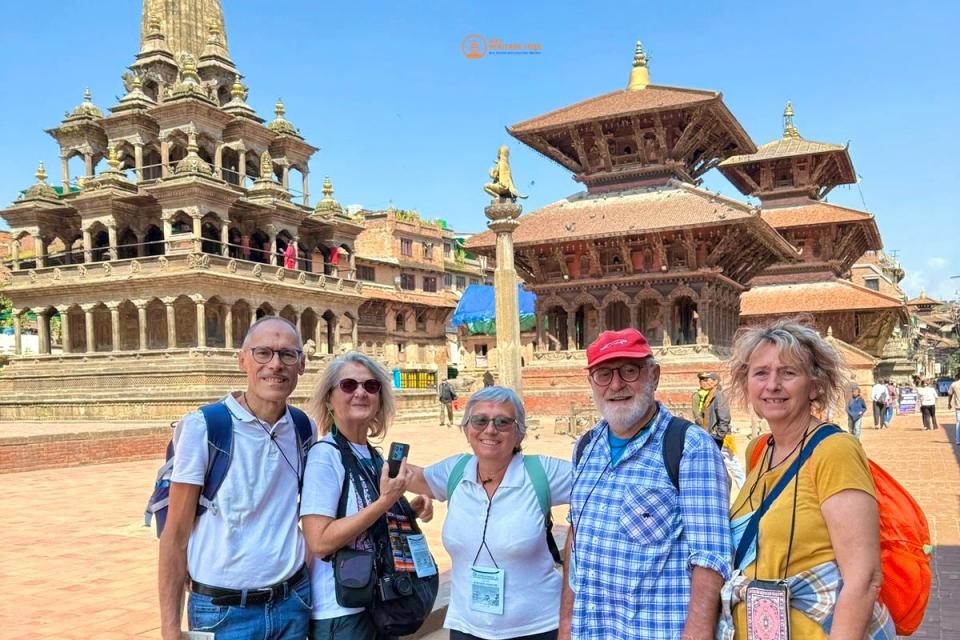Full-Day Sightseeing tour of Pashupatinath & Boudhanath Stupa
Insight on Pashupatinath & Boudhanath Stupa Tour
Embark on a spiritual journey through two of Kathmandu's most revered landmarks- Pashupatinath Temple and Boudhanath Stupa. This guided tour offers a blend of history, culture, and serenity, allowing you to experience the heart of Nepal’s Hindu and Buddhist traditions.
Trip at a Glance
Key Highlights
- Visit Pashupatinath Temple, the holiest Hindu temple in Nepal
- Explore Boudhanath Stupa, one of the largest and most sacred Buddhist stupas
- Experience the vibrant culture of Kathmandu
- Learn about the deep spiritual practices of Hinduism and Buddhism
- Witness traditional rituals and daily offerings at both sites
- Enjoy breathtaking views and serene surroundings
Benefits of Pashupatinath & Boudhanath Stupa Tour with Best Heritage Tour
- Experienced and professional tour guides enhance your understanding of each site.
- Travel in comfort with a private vehicle, ensuring a personalized experience.
- Tailored itineraries cater to your interests for a meaningful journey.
- Smooth and efficient transfers eliminate the stress of public transportation.
- Prioritized safety with reliable transportation and careful planning.
- Convenient booking and reservation process
- Multiple communication channels (Email, WhatsApp, Facebook, WeChat, Viber, Skype, Zoom)
- All logistical arrangements, including permits and transportation, are handled.
- 24/7 phone support at +977-9851149197/+9779810043046
- Simple payment system
- Free storage for excess luggage at Best Heritage Tour store during the trek
Comprehensive Overview
Kathmandu Valley, a UNESCO World Heritage site, presents a harmonious fusion of Hindu and Buddhist traditions that have profoundly influenced Nepal’s cultural and spiritual identity. This one-day tour offers a unique opportunity to explore the heart of Nepal’s ancient religious practices, awe-inspiring architecture, and rich cultural history. The journey takes you to two of the most iconic spiritual landmarks in Nepal, providing an immersive experience in both Hindu and Buddhist cultures.
Designed for travelers seeking a comprehensive cultural experience, this tour begins with a visit to Pashupatinath Temple, one of the holiest Hindu pilgrimage sites in the world. You will then proceed to Boudhanath Stupa, a vibrant center of Tibetan Buddhism. This day-long journey promises to deepen your understanding of Nepal’s spiritual heritage, creating an unforgettable and insightful adventure.
1. Pashupatinath Temple: A Sacred Hindu Pilgrimage Site
Your journey begins with a visit to Pashupatinath Temple, one of the holiest sites for Hindus and a UNESCO World Heritage site. This sacred temple, dedicated to Lord Shiva, is located on the banks of the Bagmati River, a key river in Hindu religious beliefs. The temple complex features a stunning pagoda-style architecture with intricately carved wooden rafters, copper roofs, and golden statues, representing some of the finest examples of Nepalese craftsmanship. The temple itself is a revered pilgrimage destination for Hindus from across the world, especially during the Maha Shivaratri festival when thousands of devotees gather to pay homage to Lord Shiva.
As you explore the temple, you will witness various sacred rituals being performed, such as the traditional offerings of flowers, incense, and oil lamps. The most striking and poignant aspect of the temple is the cremation ghats along the river, where cremations take place in accordance with Hindu customs. For Hindus, the cremation process is considered an important spiritual rite, as it is believed to purify the soul and help in attaining moksha (liberation). The sight of fire burning on the riverbanks, accompanied by chants and prayers, offers a deeply spiritual atmosphere, which is central to the temple’s significance.
The temple also houses various shrines dedicated to different manifestations of Lord Shiva, including the iconic golden Nandi (the bull) statue at the entrance. The atmosphere in and around the temple exudes a profound sense of spirituality, offering visitors a unique insight into Hindu practices, rituals, and philosophies. The powerful energy of this sacred site will leave you with a deeper understanding of Hinduism and its cultural importance in Nepal.
2. Boudhanath Stupa: A Center of Tibetan Buddhism
After Pashupatinath Temple, you will continue your journey to Boudhanath Stupa, one of the largest and most significant Buddhist stupas in the world. Situated in the heart of Kathmandu, Boudhanath is a vital center for Tibetan Buddhism and a key pilgrimage destination for Buddhists from Nepal, Tibet, and other parts of the world. This ancient stupa, built over 2,500 years ago, features a massive mandala design with a central dome representing the universe, and its whitewashed structure rises dramatically above the surrounding area.
What makes Boudhanath Stupa particularly unique is its symbolic representation of the path to enlightenment. Surrounding the stupa are 108 prayer wheels, each inscribed with mantras that, when spun, are believed to bring good karma and purify the mind. Pilgrims and visitors walk clockwise around the stupa, spinning the prayer wheels and reciting mantras, in a form of meditation and prayer.
The area surrounding Boudhanath Stupa is home to several monasteries and smaller stupas, each adding to the vibrant and spiritual atmosphere. You will likely encounter monks in traditional red robes, silently engaged in prayer and meditation, which provides an authentic glimpse into Tibetan Buddhist practices. The hum of chanting, the sound of prayer bells, and the fluttering of colorful prayer flags all contribute to the tranquil and meditative environment.
Boudhanath is not only a spiritual hub but also a place of cultural significance. The surrounding area is dotted with Tibetan shops, offering everything from prayer beads and incense to colorful thangkas (Buddhist paintings) and traditional Tibetan handicrafts. The peaceful surroundings, combined with the rich history and significance of the stupa, provide a deep immersion into Tibetan Buddhist culture, offering profound insights into the teachings of the Buddha and the practices followed by Buddhist monks.
Itinerary
Morning
8:00 AM - 8:30 AM: Pickup and Start of the Tour
Your guide and driver will pick you up from your hotel in Kathmandu and take you to Pashupatinath Temple.
8:30 AM - 12:00 PM: Visit Pashupatinath Temple
- Discover the sacred Pashupatinath Temple, a UNESCO World Heritage Site and one of Nepal's most significant Hindu pilgrimage destinations.
- Spend time exploring the intricate architecture of the main temple, adorned with beautiful carvings and golden spires.
- Observe rituals and ceremonies performed by priests and devotees, including morning prayers and offerings.
- Witness the cremation rituals along the Bagmati River at the Arya Ghat, gaining insight into Hindu beliefs about life and death.
- Explore the surrounding areas, including smaller temples, shrines, and the nearby forested trails that exude spiritual tranquility.
- Take your time to immerse yourself in the spiritual ambiance and interact with sadhus (Hindu ascetics) for a deeper understanding of their lifestyle.
12:00 PM - 12:30 PM: Transfer to Boudhanath Stupa
A short drive of approximately 15–20 minutes will take you to Boudhanath Stupa.
12:30 PM - 1:30 PM: Lunch Break
Savor a delicious Nepali or Tibetan lunch at a local restaurant overlooking Boudhanath Stupa, enjoying the peaceful views and cultural charm.
Midday
1:30 PM - 3:00 PM: Visit Boudhanath Stupa
- Marvel at Boudhanath Stupa, one of the largest and most iconic Buddhist stupas in the world.
- Walk around the stupa (kora) in a clockwise direction, spinning prayer wheels and soaking in the serene ambiance.
- Visit nearby monasteries, such as Shechen Monastery, and learn about Tibetan Buddhist traditions and practices.
- Explore the vibrant market area, where you can find Tibetan handicrafts, prayer flags, and spiritual souvenirs.
Afternoon
3:00 PM - 4:00 PM: Further Exploration of Boudhanath
- Delve deeper into the spiritual and cultural essence of Boudhanath by visiting additional nearby monasteries, such as Kapan Monastery.
- Engage with monks to gain insight into Buddhist philosophy and meditation practices.
- Optionally, visit the Tibetan Refugee Camp to witness traditional crafts like thangka painting and carpet weaving.
4:00 PM - 4:30 PM: Return to Hotel
Your guide and driver will transfer you back to your hotel in Kathmandu, concluding a memorable day of cultural and spiritual exploration.
End of the Tour
This extended itinerary offers a deeper, more immersive experience at both Pashupatinath Temple and Boudhanath Stupa, with opportunities for reflection, cultural exploration, and spiritual enrichment.
What is included?
- Private vehicle for comfortable transportation throughout the tour
- Bottled water for hydration
- Visits to nearby monasteries and cultural sites
- Insightful explanations about Hindu and Buddhist rituals and practices
- Hotel pickup and drop-off within Kathmandu
- Driver salary allowances
What is not included?
- Personal expenses such as souvenirs, additional meals, or drinks
- Tips for the guide and driver
- Optional visits to additional attractions not mentioned in the itinerary
- Photography fees (if applicable in some areas)
- Travel insurance
- Any expenses not mentioned in the Include section
- A licensed English-speaking tour guide from the Best Heritage Tours
- Entrance fees to Pashupatinath Temple and Boudhanath Stupa
- Traditional Nepali or Tibetan lunch at a local restaurant
- All government taxes 13%, SSF, and 10% service charges
Route Map
Equipment
For a smooth and enjoyable experience during your Sacred Sights of Kathmandu tour, it's essential to be well-prepared with the right equipment and gear. Whether you're visiting temples, walking around stupas, or exploring cultural sites, the following items will ensure you stay comfortable, protected, and ready to capture memories.
- Comfortable walking shoes
- Lightweight clothing (appropriate for the season)
- Sunscreen and hat for sun protection
- Camera or smartphone for photos
- Water bottle to stay hydrated
- Optional: A scarf or shawl (for visiting temples)
Trip Info
Best Season for the Pashupatinath Temple & Boudhanath Stupa One Day Tour
The most favorable times to visit Pashupatinath Temple and Boudhanath Stupa are during spring (March to May) and autumn (September to November). These seasons provide pleasant temperatures, clear skies, and ideal conditions for sightseeing. Spring brings blooming flowers and lush greenery, while autumn offers cooler air and uninterrupted views of the surrounding mountains and landscapes. These months also coincide with various festivals, enriching the cultural and spiritual experience of the tour.
It’s best to avoid the monsoon season (June to August) due to heavy rain, which can make the streets slippery and hinder outdoor activities. Winter (December to February) is another possibility, though it can be quite chilly, particularly in the early mornings and evenings, which could make walking around less comfortable.
Additional Information
- Pashupatinath Temple: This sacred Hindu temple is dedicated to Lord Shiva. Non-Hindus are not allowed inside the temple's inner sanctum, but the outer area and the surrounding ghats (steps) can be visited. Respect for the rituals and customs is essential when visiting.
- Boudhanath Stupa: This site is the center of Tibetan Buddhism in Nepal. The stupa is an important pilgrimage site for Buddhists, with prayer flags often seen fluttering in the wind around the stupa. The area is home to several Tibetan monasteries and is known for its tranquil ambiance.
- Photography: Photography is allowed in most areas of both sites, but please be respectful, especially during religious ceremonies.
- Dress Code: While there is no strict dress code, modest attire is appreciated. Avoid revealing clothing, especially when visiting temples and religious sites.
- Cultural Etiquette: When visiting temples and stupas, always walk in a clockwise direction around the stupa and avoid touching religious artifacts unless invited to do so.
This tour offers an enriching day filled with cultural, spiritual, and historical experiences. Whether you're a cultural enthusiast or a spiritual seeker, this tour provides the perfect opportunity to explore the sacred heart of Kathmandu.
Review
A cultural rich tour
Must say Pashupatinath and Boudhanath day tour was great tour in which I experienced and explored both Hindu and Buddhist religions and well as their respective culture. Mr Bimal...
View DetailA perfect mix tour of Hinduism and Buddhism
Pashupatinath and Boudhanath tour was one of the most interesting and a unique type of tour in Kathmandu valley. For me this tour was the cultural and religion exploration of Hindu...
View Detailwell managed cultural tour
A perfect cultural tour in Kathmandu valley. I got to taste the authentic Tibetan cuisine in Boudhanath. The tour was well managed and well-paced by the best heritage tour. I got...
View DetailA family friendly religious and cultural tour
We booked the Pashupatinath and Boudhanath tour with best heritage tour and it was a great family tour. We loved this tour and my children got to know about the different culture...
View DetailFAQ's
While Nepali is the primary language, most staff members in lodges speak English, and some may even speak other languages. Communication should not be an issue for international tourists.
It’s advisable to be up-to-date on routine vaccinations, including hepatitis A and typhoid. Talk to your doctor about the vaccinations you need for Nepal.
The majority of international flights arrive at Tribhuvan International Airport, which is located in Kathmandu. From this location, travelers can connect to Lukla to commence their trekking journey.
You typically need a valid passport, a completed visa application form, and a passport-sized photo. Payment can be made in cash or via card at the airport.
Yes, tourist visas are eligible for extension at the Department of Immigration located in Kathmandu. Ensure you have a valid reason and required documents for the extension.
If you wish to extend your stay in Nepal beyond your visa’s initial duration, you can do so by applying at the Department of Immigration in Kathmandu. Extensions are available for a maximum of 30 days, and it’s recommended to apply before your current visa expires. Best Heritage Tour can help you with the extension process if required during your Australian Camp Trek.
The Full Day Sightseeing Tour of Pashupatinath and Boudhanath Stupa includes private vehicle transport, a knowledgeable tour guide, and entry fees to the temples and stupas. You will visit the famous Pashupatinath Temple, known for its religious significance, and the majestic Boudhanath Stupa, a UNESCO World Heritage Site. The tour also provides cultural insights and an opportunity to experience Nepal's rich heritage. Best Heritage Tour ensures a seamless experience with expert guides and comfortable transportation.
The tour typically lasts for 7-8 hours, starting with a visit to Pashupatinath in the morning and followed by a trip to Boudhanath Stupa. You will have sufficient time at each location to explore, learn, and capture the spiritual essence of these iconic landmarks. Best Heritage Tour aims to make your visit enriching and memorable.
The best time for the Full Day Sightseeing Tour of Pashupatinath and Boudhanath Stupa is from September to December and March to May. These months offer pleasant weather and clear skies, making the sightseeing experience more enjoyable. However, the tour is available year-round, and Best Heritage Tour is flexible in accommodating your preferred dates.
Yes, the Full Day Sightseeing Tour is family-friendly. It involves light walking and is suitable for all age groups. The visit to Pashupatinath and Boudhanath Stupa provides an opportunity for both adults and children to learn about Nepali culture, history, and spirituality in an engaging way. Best Heritage Tour ensures that the tour is comfortable for all participants, including families.
Yes, you can easily book the Full Day Sightseeing Tour of Pashupatinath and Boudhanath Stupa in advance through the Best Heritage Tour website. Advanced booking helps to secure your spot and allows our team to prepare for your arrival with the best service possible.
Dress modestly, avoid touching religious artifacts, and always walk clockwise around stupas and temples. Respect the customs and rituals being performed, and seek permission before photographing religious activities or individuals.
Near Pashupatinath, you can explore forest trails and smaller shrines. Around Boudhanath, you can visit Tibetan shops, Shechen Monastery, and other smaller stupas or opt for cultural activities such as thangka painting demonstrations.
Best Heritage Tour provides flexible itineraries to accommodate specific interests, additional stops, or adjusted timing, ensuring a personalized experience for all travelers.
Pashupatinath Temple is one of the most sacred Hindu temples dedicated to Lord Shiva, also known as Pashupati, the lord of animals and all living beings. Situated on the banks of the Bagmati River in Kathmandu, Nepal, it holds immense spiritual and cultural importance. The temple is a UNESCO World Heritage Site and attracts millions of pilgrims annually, especially during Maha Shivaratri, when devotees gather to honor Lord Shiva. The temple complex is a symbol of religious harmony, as it also hosts shrines and inscriptions linked to other cultures and traditions. Its history dates back to 400 AD, making it a cornerstone of Nepali heritage.
The Pashupatinath Temple complex includes several features of architectural and spiritual significance. The main temple has a two-tiered golden roof, silver-plated doors, and intricate wood carvings, reflecting the pagoda-style architecture. It houses a large black stone Shiva lingam, the primary object of worship. The complex also features numerous smaller temples, ashrams, and inscriptions. Along the Bagmati River, the ghats are used for ritual bathing and cremation ceremonies. The surroundings include beautiful gardens and sanctuaries for meditation, making it a holistic spiritual experience.
Non-Hindus are not allowed to enter the inner sanctum of the main temple but are welcome to explore the temple premises and observe its rich cultural heritage. From the outer area, visitors can view the temple's majestic architecture and witness rituals from a designated spot. The restrictions aim to preserve the sanctity of the temple, as it is a place of worship. However, the broader complex, including other smaller temples and shrines, is open to people of all faiths.
The temple can be visited year-round, but the most auspicious and vibrant time is during Maha Shivaratri, usually celebrated in February or March. This festival sees an influx of devotees, including sadhus from India and Nepal. Early mornings are ideal for experiencing daily rituals, such as the aarti and offerings to Lord Shiva. Sunset is another enchanting time, as the Bagmati River aarti ceremony takes place, blending music, chanting, and devotion in a mesmerizing ambiance.
Photography is permitted in certain areas of the temple complex but strictly prohibited inside the main temple and during sacred rituals. Visitors should respect the privacy and sanctity of the site, especially during cremation ceremonies on the ghats. Capturing the architecture, the Bagmati River, and other shrines is allowed, but it's essential to seek guidance from temple authorities or signage to avoid unintentional breaches of protocol.
Pashupatinath Temple is located about 5 kilometers east of central Kathmandu, near the Tribhuvan International Airport. Visitors can reach the temple by taxi, private vehicle, or local buses. For a more convenient journey, many tourists opt for guided tours organized by agencies like Best Heritage Tour, ensuring a seamless visit to the temple along with insights into its cultural and historical context.
Yes, Pashupatinath Temple is known for its elaborate rituals and ceremonies dedicated to Lord Shiva. Daily offerings include the morning abhisheka (sacred bath) of the Shiva lingam, with milk, water, honey, and other items. The Bagmati aarti held every evening on the riverbank is another highlight, featuring devotional songs, prayers, and lighting of oil lamps. During Maha Shivaratri, special pujas and events take place, attracting thousands of devotees. Visitors can also witness cremation rituals, which are an integral part of Hindu traditions.
Visitors to Pashupatinath Temple can explore several nearby attractions that complement their spiritual journey. The Boudhanath Stupa, a significant Buddhist pilgrimage site, is just a short drive away and offers a serene environment for meditation. The Guhyeshwari Temple, located nearby, is another revered site dedicated to Goddess Parvati. For a broader cultural experience, the Patan Durbar Square and Bhaktapur Durbar Square are also accessible within a short distance, showcasing Nepal's rich architectural and cultural history.
Yes, international tourists are required to pay an entry fee to access the temple complex, while Nepali citizens and Indian nationals can enter free of charge. The fee contributes to the maintenance and preservation of the temple, ensuring its sanctity and upkeep. Prices may vary, so it’s advisable to check with the temple authority or your tour operator for updated information. Guided tours, like those offered by Best Heritage Tour, often include the entry fee in their packages for convenience.
Visitors are advised to wear modest and respectful clothing when visiting Pashupatinath Temple. As it is a place of worship, attire that covers shoulders, knees, and midriff is preferred. Traditional or simple clothing is appreciated, as it aligns with the temple's spiritual ambiance. Comfortable shoes are also recommended, as visitors may need to walk through the vast temple complex and ascend some stairs. Avoid wearing leather items, as they are considered inappropriate in Hindu religious contexts.
To fully experience the spirituality of Pashupatinath Temple, it’s best to participate in the daily rituals, observe the aarti (prayer ceremony), and spend time at the ghats along the Bagmati River. The evening aarti, which involves the lighting of lamps and chanting, creates an ethereal atmosphere. Visitors can also sit quietly near the riverbanks, absorbing the sacredness of the surroundings. For a deeper spiritual connection, many people choose to meditate or reflect in the peaceful courtyards and gardens of the temple complex. It’s recommended to visit with a guide from Best Heritage Tour to gain insights into the rituals and history that enhance the experience.
Yes, Pashupatinath Temple offers peaceful spaces for meditation and quiet reflection. The temple’s surrounding courtyards, gardens, and the riverbank near the cremation ghats provide a serene environment. The temple complex itself is often calm, allowing visitors to sit and meditate. Many devotees and pilgrims visit the temple for spiritual reflection, and the tranquil atmosphere makes it an ideal place for personal prayer or meditation. Visitors can also choose to participate in the temple’s meditation programs, if available, or simply enjoy the peaceful ambiance.
While visitors are not allowed to perform the main rituals inside the temple, they can participate in certain practices from the temple’s outer areas. Many tourists engage in the offering of flowers, incense, and fruit to Lord Shiva. Additionally, visitors may be invited to join in prayers and aarti ceremonies, which take place both in the morning and evening. For a deeper connection, visitors can observe the cremation rituals along the Bagmati River, which hold great significance in Hindu traditions as part of the cycle of life and death.
The Pashupatinath Temple is believed to have been established in the 5th century, though its history stretches back even earlier. The temple has been expanded and renovated by various rulers throughout Nepal's history. The earliest records mention a shrine built by King Amsuvarma in the 4th century, and later kings like Malla monarchs played an important role in enhancing the temple's architectural and cultural value. Over time, it has become a key center of Hinduism, drawing millions of pilgrims, both local and international, who come to seek blessings and offer prayers.
The cremation rituals at Pashupatinath Temple take place at the ghats along the Bagmati River, an essential aspect of Hindu funeral rites. Hindus believe that cremation on these sacred ghats grants spiritual liberation (moksha) and releases the soul from the cycle of birth and rebirth. Visitors can observe the process from a respectful distance, but should be mindful of the cultural sensitivity of the practice. The cremations are a deeply personal and sacred ritual, and it’s important to show respect during your visit. The presence of sadhus (holy men) and priests at the ghats adds to the spiritual significance of the site.
Yes, Pashupatinath Temple hosts several significant festivals, the most notable being Maha Shivaratri, a celebration dedicated to Lord Shiva. During this festival, thousands of devotees from Nepal and India gather to offer prayers, perform rituals, and partake in fasting and meditation. The temple becomes a vibrant center of devotion with special pujas and religious gatherings. Tihar, the festival of lights, is another key celebration at the temple, during which the temple is illuminated, and various ceremonies are held in honor of Lord Shiva. Teej, a festival dedicated to women, is also observed at Pashupatinath, attracting a large number of women who come to worship for marital bliss.
Sadhus, or ascetics, play a significant role in the spiritual atmosphere of Pashupatinath Temple. Many sadhus live in and around the temple complex, devoting their lives to meditation, prayer, and spiritual practices. They are revered figures in Hinduism, often seen meditating by the riverbanks or performing rituals for devotees. Sadhus are also a part of the spiritual landscape during festivals, such as Maha Shivaratri, where they bless pilgrims and engage in religious discussions. Visitors can interact with sadhus, but it’s important to approach them with respect, as they represent the deeper spiritual traditions of Hinduism.
The dress code for visiting Pashupatinath Temple is centered around modesty and respect for the sacred nature of the temple. It is recommended to dress conservatively, covering the shoulders, arms, and legs. Both men and women should avoid wearing shorts or sleeveless attire. Traditional or simple clothing such as long skirts, pants, or dresses is preferred. Footwear should be removed before entering sacred spaces, and visitors should also refrain from wearing leather goods, as they are considered inappropriate in Hindu temples.
Yes, guides are available at Pashupatinath Temple for those who wish to gain a deeper understanding of its history, rituals, and cultural significance. Guided tours are an excellent way to learn about the temple’s architecture, spiritual practices, and the various deities housed within the complex. Many tour companies, such as Best Heritage Tour, offer guided visits to Pashupatinath Temple, ensuring a comprehensive and enriching experience. A local guide will also help visitors navigate the temple’s vast grounds and provide valuable context to the rituals observed at the temple.
Pashupatinath Temple is open every day of the week, and the general visiting hours are from 4:00 AM to 7:00 PM. The temple opens early in the morning to allow visitors to attend the morning aarti (prayer ceremony) and participate in the early rituals. The temple gates close at 7:00 PM, after the evening aarti and other ceremonies are completed. During major festivals like Maha Shivaratri, the temple may extend its hours to accommodate the increased number of devotees. It's advisable to check with your tour operator or the temple authorities for any special timing changes around religious festivals or events.
Boudhanath Stupa, also known as the Boudha Stupa, is one of the largest and most significant Buddhist stupas in Nepal. Located in the Kathmandu Valley, it is a UNESCO World Heritage Site and an important pilgrimage destination for Tibetan Buddhists. The stupa’s structure is a massive mandala that symbolizes the universe. Visitors are often captivated by the vastness of the monument, its spiritual ambiance, and the many prayer flags fluttering in the wind, adding to its serene atmosphere.
Boudhanath Stupa is easily accessible from Kathmandu, located about 7 kilometers to the northeast of the city center. You can take a taxi, rent a private vehicle, or use public transportation. Many visitors choose to hire a taxi or take a guided tour for ease and comfort, especially for those unfamiliar with the area. Alternatively, there are also bicycles and rickshaws available for a more local experience.
The origins of Boudhanath Stupa date back to the 5th century. It is believed to have been built during the reign of King Mandev, though some legends suggest it was constructed over an earlier stupa by King Trisong Detsen of Tibet. The stupa is said to house the relics of Kashyapa Buddha, and it has undergone significant reconstruction and renovations over the centuries. It remains a focal point of Tibetan Buddhism in Nepal, with many Tibetan refugees living in the surrounding areas, contributing to the stupa’s cultural significance.
Around the Boudhanath Stupa, there are numerous monasteries, Tibetan Buddhist shrines, and stupas. The area is also filled with cafes, shops selling Buddhist artifacts, prayer wheels, and colorful Tibetan flags. Visitors can walk around the stupa, perform the kora (a clockwise circumambulation), and observe the daily rituals of monks and local worshippers. The nearby Shechen Monastery, Zhaibung Monastery, and the Tibetan Refugee Camp offer further cultural and spiritual insights.
The eyes of the Buddha, painted on all four sides of the stupa’s central tower, are one of the most recognizable features of Boudhanath Stupa. They symbolize the omniscient vision of the Buddha, watching over all sentient beings. The eyes are often referred to as the "All-Seeing Eyes" and represent the Buddha's insight and wisdom. Between the eyes, the third eye is depicted, symbolizing wisdom and the ability to see the true nature of reality.
Yes, visitors are welcome to participate in religious activities at Boudhanath Stupa. Many tourists choose to walk around the stupa while chanting mantras and spinning prayer wheels, a practice that is believed to bring spiritual merit. Visitors can also join the local community in making offerings such as butter lamps or incense. However, it is important to maintain respect for the local customs and follow appropriate etiquette, such as walking around the stupa in a clockwise direction.
The best time to visit Boudhanath Stupa is during the early morning or late afternoon. Early morning visits allow you to experience the peaceful and serene atmosphere of the stupa, and you can see local worshippers performing their rituals. The late afternoon provides a beautiful view of the stupa as the sun sets, and the area comes alive with locals and tourists. The stupa is open year-round, though it can get crowded during major Buddhist festivals such as Buddha Jayanti or Losar (Tibetan New Year).
As of now, there is no entrance fee to visit Boudhanath Stupa. However, there are fees for entering some of the surrounding monasteries, and you may be asked for donations by some of the monks or organizations within the area. It is always a good practice to contribute if you feel moved to do so, as it helps maintain the religious sites and supports the local Tibetan community.
When visiting Boudhanath Stupa, it is advisable to dress modestly and respectfully, especially as it is a religious site. While there is no strict dress code, visitors should avoid wearing revealing clothing. Comfortable shoes are recommended for walking around the stupa, as it involves circumambulating the structure and exploring the surrounding areas. In general, respectful attire is appreciated at all religious and cultural sites in Nepal.
In addition to visiting the stupa itself, there are several activities you can enjoy near Boudhanath. You can explore the nearby monasteries, where you can learn about Tibetan Buddhism and witness the monks’ daily life. The Boudhanath area is also a great place to shop for Tibetan handicrafts, prayer beads, incense, and other religious items. There are also a number of Tibetan restaurants and cafes where you can taste traditional Tibetan cuisine, such as momo (dumplings) and butter tea.
Boudhanath Stupa holds immense spiritual significance for both locals and international Buddhist pilgrims. It is considered one of the holiest sites in Nepal for Tibetan Buddhists and is a major hub for Buddhist culture. The stupa represents the Buddha’s mind and is believed to be a place where the energies of the universe converge. Pilgrims perform kora (circumambulation) to gain spiritual merit and seek blessings for peace and enlightenment. The stupa is also associated with the teachings of the Vajrayana Buddhist tradition, particularly Tibetan Buddhism.
Boudhanath Stupa is a central place of celebration for several important Buddhist festivals, including Buddha Jayanti, Losar (Tibetan New Year), and Sakadawa. During Buddha Jayanti, the stupa is beautifully decorated, and thousands of devotees gather to commemorate the birth, enlightenment, and death anniversary of Lord Buddha. Losar, the Tibetan New Year, is another major celebration marked by special prayers, rituals, and cultural performances, creating a vibrant atmosphere around the stupa. These festivals draw large crowds and provide visitors with a unique opportunity to witness Tibetan Buddhist culture.
Yes, Boudhanath Stupa is a living religious site where you can observe numerous rituals performed by local Buddhists and monks. Visitors can witness devotees performing prayer circumambulation, where they walk around the stupa in a clockwise direction, often reciting mantras or spinning prayer wheels. You may also observe the offering of butter lamps, which are believed to dispel darkness and bring light into the lives of worshippers. Another significant ritual is the chanting of prayers by monks inside the monasteries, creating a tranquil atmosphere for contemplation.
The structure of Boudhanath Stupa is an architectural marvel. It features a massive mandala-shaped base, symbolizing the universe. The central tower has a dome-like structure representing the mind of the Buddha. At the top of the tower is a tower-like spire, symbolizing the unity of wisdom and compassion. The eyes of the Buddha painted on all four sides of the stupa represent the all-seeing awareness of the Buddha. The stupa is also surrounded by prayer wheels, which visitors can spin to accumulate spiritual merit. The site exudes a sense of peace, with its harmonious proportions and rich symbolism.
The prayer wheels surrounding Boudhanath Stupa are an essential part of the pilgrimage experience. Each prayer wheel contains a scroll inscribed with mantras, typically the Om Mani Padme Hum mantra, which is considered sacred in Tibetan Buddhism. Spinning these prayer wheels is believed to have the same spiritual effect as reciting the mantras themselves. Devotees often spin the wheels as they walk around the stupa, adding to the spiritual energy of the place. Visitors are encouraged to spin the prayer wheels in a clockwise direction as a gesture of respect and to align with the flow of positive energy.
Yes, visitors can explore several Tibetan Buddhist monasteries around Boudhanath Stupa. These monasteries are integral to the religious life in the area and offer insight into Tibetan Buddhism. Notable monasteries include the Shechen Monastery, which is known for its beautiful murals and peaceful ambiance, and the Zhaibung Monastery, where Tibetan monks perform daily rituals. Some monasteries allow visitors to join in prayer sessions or learn about Buddhist teachings. The monasteries also house libraries with Tibetan Buddhist texts and artifacts, making them great spots for those seeking a deeper spiritual experience.
The kora is the act of walking around the stupa in a clockwise direction. It is a deeply spiritual practice for Buddhists and is believed to purify the mind, body, and soul. The kora around Boudhanath Stupa is a common ritual performed by both locals and pilgrims, who often do it as a form of meditation, prayer, or offering. The practice symbolizes the journey of life and the path towards enlightenment. Performing a kora is considered to bring good karma and is a way to connect spiritually with the Buddha.
Photography is allowed at Boudhanath Stupa, but visitors should exercise caution and respect for the local customs. When taking photos, it is important to avoid disturbing the worshippers or their rituals. For instance, while photographing monks or worshippers, it is respectful to ask for permission beforehand. It is also important to refrain from using flash photography in areas of the stupa where it might interrupt the tranquility of the site. Always be mindful of the cultural and religious significance of the place, ensuring that your actions are considerate of the sacredness of the location.
Boudhanath Stupa is open to visitors every day of the week, including holidays. The stupa itself is accessible at any time, although it is recommended to visit during the day when the area is most active, and you can observe the spiritual practices of the monks and devotees. The surrounding shops and cafes usually open from around 8 AM and close by 7 PM. The stupa is particularly serene and peaceful in the early morning hours before the crowds arrive, making it an excellent time for those seeking a quiet and reflective visit.
Yes, there are several accommodations near Boudhanath Stupa, ranging from guesthouses to mid-range hotels. Many of these offer views of the stupa and provide a peaceful and culturally immersive experience. Staying in the Boudhanath area allows easy access to the stupa and the surrounding monasteries. The area also has restaurants and cafes that cater to tourists, offering Tibetan and Nepali cuisine. For those seeking a more traditional experience, there are Tibetan guesthouses that provide a unique cultural atmosphere and often feature local Tibetan art and prayer flags.
The weather in Kathmandu is generally mild and pleasant throughout the year. During the dry season (October to April), temperatures range from 15°C to 25°C. During the monsoon (June to September), rain showers are common, and temperatures range from 20°C to 30°C. Best Heritage Tour recommends checking the weather forecast before your tour to dress accordingly.
For the Full Day Sightseeing Tour of Pashupatinath and Boudhanath Stupa, we suggest wearing comfortable clothing, such as light pants or shorts, a T-shirt, and a hat for sun protection. As the temples and stupas require visitors to dress modestly, you should also carry a shawl or scarf to cover your shoulders. In colder months, a light jacket may be needed, especially in the mornings. Best Heritage Tour provides additional advice to ensure your comfort.
Yes, the tour operates throughout the year, including during the monsoon season. However, be prepared for possible rain showers. It’s advisable to carry an umbrella or raincoat. Best Heritage Tour ensures that transportation and arrangements are comfortable regardless of the weather conditions.
During the summer (May to August), the temperatures can reach 30°C and above. While it may feel hot, the tour is still enjoyable as the temples and stupas offer shaded areas to rest. We suggest staying hydrated and wearing sunscreen. Best Heritage Tour ensures that the tour is conducted at a comfortable pace, allowing you to stay cool.
The best time for sightseeing at Pashupatinath and Boudhanath Stupa is early in the morning or late afternoon, as these times avoid the midday heat and the crowds. Best Heritage Tour recommends starting early for a peaceful experience and to capture the beauty of the sites during the soft morning light.
Arriving in Kathmandu is easy, as Tribhuvan International Airport (KTM) is well-connected to major cities worldwide. Once you arrive, a private vehicle from Best Heritage Tour can pick you up and take you directly to your hotel. The tour itself starts with a pickup from your accommodation.
Yes, most travelers need a visa to enter Nepal. You can obtain a tourist visa upon arrival at the airport or apply for one in advance at your nearest Nepali embassy. The visa is typically valid for 15, 30, or 90 days. Best Heritage Tour can assist you with any visa-related queries and provide guidance for your smooth arrival.
Both Pashupatinath and Boudhanath Stupa are located within Kathmandu city, around a 20-30 minute drive from the airport, depending on traffic. Best Heritage Tour ensures a comfortable and efficient transfer to these destinations, allowing you to start your tour without delays.
Yes, you can extend your stay in Nepal after the tour. Many visitors enjoy exploring more of Kathmandu or traveling to other regions of Nepal. Best Heritage Tour can assist you with booking additional tours and arranging accommodations for your extended stay.
You may exchange currency at the airport or at various banks and exchange centers in Kathmandu. The local currency is Nepali Rupees (NPR). While most places accept cards, it’s a good idea to carry some cash for smaller purchases. Best Heritage Tour can also provide assistance with currency exchange if needed.
The cost of the Full Day Sightseeing Tour of Pashupatinath and Boudhanath Stupa includes transportation, a professional guide, and entry fees to both the Pashupatinath Temple and Boudhanath Stupa. Any additional expenses, such as meals or souvenirs, are not included. Best Heritage Tour ensures that all essential services are covered in the cost.
While the main costs are covered, additional expenses like meals, drinks, tips, or personal items such as souvenirs are not included in the tour price. Best Heritage Tour suggests carrying extra money for such expenses and will advise you on estimated costs.
Yes, Best Heritage Tour offers secure online payment options for the Full Day Sightseeing Tour. You can pay through various methods, including credit card, PayPal, or bank transfer. Advance payment is encouraged for securing your booking.
Refunds are available if you cancel your booking at least 48 hours in advance. If you cancel less than 48 hours before the tour or fail to show up, a refund will not be issued. Best Heritage Tour encourages travelers to notify us in case of any changes to avoid unnecessary charges.
Tips are not included in the tour cost of the Pashupatinath and Boudhanath Stupa Sightseeing tour. While tipping is not mandatory, it is appreciated for excellent service. If you’re satisfied with the tour guide’s service, you may offer a tip based on your discretion. Best Heritage Tour ensures that your guide provides high-quality service, enhancing your overall experience.
Yes, the Full Day Sightseeing Tour is family-friendly and suitable for children. The tour involves light walking around the temples and stupas, making it easy for children to join and learn about Nepali culture and history. Best Heritage Tour ensures that families with children have a safe and enjoyable experience.
There are no specific age restrictions for the Full Day Sightseeing Tour. The tour is designed for all ages, from young children to elderly travelers. Best Heritage Tour makes accommodations for people of all ages and ensures a comfortable experience for everyone.
The Full Day Sightseeing Tour is not physically demanding. The walking required is light and leisurely, making it accessible to individuals of all fitness levels. Best Heritage Tour ensures that the tour is comfortable for everyone, regardless of fitness level.
Yes, the Full-Day Pashupatinath and Boudhanath Stupa Sightseeing Tour is suitable for elderly people. The tour involves minimal walking, and we ensure plenty of rest breaks. Best Heritage Tour ensures that transportation and the pace of the tour are comfortable for older travelers.
Yes, solo travelers are welcome to join the full-day Pashupatinath and Boudhanath Stupa Sightseeing Tour. Best Heritage Tour will match you with a group if you prefer, or you can choose a private tour option for a more personalized experience.
The Full Day Sightseeing Tour of Pashupatinath and Boudhanath Stupa does not include meals in the basic tour price. However, lunch can be arranged at a local restaurant, where you can enjoy traditional Nepali cuisine. Best Heritage Tour offers recommendations for restaurants where you can enjoy a variety of meal options, including vegetarian, non-vegetarian, and local dishes.
If you choose to extend your stay in Kathmandu after the sightseeing tour, Best Heritage Tour can help you find accommodations that fit your preferences and budget. Options range from budget guesthouses to mid-range hotels and luxury accommodations. You can discuss your preferences with us, and we will provide suitable recommendations.
Yes, Best Heritage Tour can accommodate special dietary requests, including vegetarian, vegan, gluten-free, or other specific requirements. Please inform us of your dietary preferences in advance, and we will ensure that your meals align with your needs. Many restaurants in the Kathmandu Valley offer diverse food options to cater to different dietary restrictions.
Bottled water is not included in the basic cost of the Full Day Sightseeing Tour. However, it is recommended to carry your own water, as staying hydrated during the tour is important, especially if you are visiting during warmer months. You can also purchase water at various locations during the tour. Best Heritage Tour encourages travelers to carry their own water and snacks for comfort.
During the tour, lunch will be arranged at a local restaurant, typically near the Boudhanath Stupa or Pashupatinath Temple. These areas have a variety of eateries where you can enjoy authentic Nepali food. If you prefer a specific type of meal, Best Heritage Tour can also guide you to other restaurants based on your preferences.
For the Full Day Sightseeing Tour of Pashupatinath and Boudhanath Stupa, we recommend comfortable clothing, such as lightweight pants or skirts and a comfortable T-shirt. It’s important to dress modestly, especially when visiting the temples. Carry a light jacket for cooler mornings or evenings, as temperatures can vary. Best Heritage Tour will guide you on appropriate attire to ensure respect for local customs.
While no specific hiking gear is required for the Full Day Sightseeing Tour, we recommend carrying a hat, sunglasses, and sunscreen to protect yourself from the sun. Comfortable walking shoes are also important since you’ll be walking around the temples and stupa. Best Heritage Tour ensures that the tour is easy and comfortable for all participants, regardless of what gear you bring.
Yes, bringing a camera is highly recommended to capture the spiritual and architectural beauty of Pashupatinath and Boudhanath Stupa. Both sites offer stunning views and photo opportunities. A portable charger for your camera or phone is also a good idea, especially if you plan to take a lot of photos. Best Heritage Tour can provide guidance on the best spots for photos during the tour.
We recommend carrying a small first aid kit with basic medications, especially if you have specific health concerns. Also, bringing a water bottle, some snacks, and hand sanitizer can enhance your comfort throughout the day. Best Heritage Tour ensures that you have everything you need for a smooth and enjoyable experience.
To prepare for the Full Day Sightseeing Tour, it’s important to rest well the night before the tour. You may want to bring a small daypack with essentials such as water, sunscreen, and any personal items you need. Arriving early and being well-prepared will ensure you make the most of the day. Best Heritage Tour will provide you with all the necessary information ahead of the tour to ensure you are well-prepared.
The Full Day Sightseeing Tour is not physically demanding. It involves light walking around Pashupatinath and Boudhanath Stupa, with plenty of opportunities to rest. The pace is leisurely, and no strenuous physical activity is involved, making it suitable for people of all ages and fitness levels. Best Heritage Tour ensures that the tour is comfortable and enjoyable for everyone.
No, you do not need to be highly physically fit for the Full Day Sightseeing Tour. The tour is designed for all participants, regardless of fitness level. There are no long hikes or difficult terrains involved, making it accessible to those who may not be accustomed to physical exertion. Best Heritage Tour ensures a comfortable experience, even for those with limited mobility.
Yes, elderly participants can comfortably join the Full Day Sightseeing Tour. Since the tour involves minimal walking and includes rest breaks, it is ideal for elderly travelers. Best Heritage Tour ensures a smooth and comfortable experience with proper support and pacing for seniors.
If you are concerned about your fitness level, it’s always a good idea to take a short walk a day or two before the tour to get your body accustomed to walking for an extended period. However, you should not need to do any intense physical preparation for the Full Day Sightseeing Tour, as the walking is light. Best Heritage Tour ensures the tour is suitable for all levels of fitness.
No, the Full Day Sightseeing Tour does not include any strenuous activities. The tour involves leisurely walking at a comfortable pace, with plenty of opportunities for rest. It is suitable for participants who may not be accustomed to hiking or strenuous physical activities. Best Heritage Tour ensures that the tour is accessible and enjoyable for everyone.
Before the Full Day Sightseeing Tour, it is recommended to drink plenty of water and ensure you are in good general health. If you have any medical conditions, bring necessary medications. It’s also advisable to bring hand sanitizer and tissue for hygiene. Best Heritage Tour ensures that safety measures are in place, including providing guidance on staying healthy during the tour.
There are no specific vaccinations required for the Full Day Sightseeing Tour of Pashupatinath and Boudhanath Stupa. However, it’s always a good idea to check with your doctor regarding any recommended vaccinations for travel to Nepal. Best Heritage Tour can provide additional health and safety information based on your personal health status.
Yes, the Full Day Sightseeing Tour is safe for children. The walking is light and manageable, and the sites are family-friendly. Best Heritage Tour ensures that the tour is conducted safely, with a guide who can assist and engage children, making the experience enjoyable for them as well.
If you feel unwell during the tour, inform your guide immediately. Best Heritage Tour provides all necessary support and will adjust the tour as needed. There are also nearby medical facilities, and our guide will ensure you receive assistance if required.
During the tour, it’s important to respect local customs and traditions, especially in religious sites like Pashupatinath and Boudhanath. Always stay with the group, and avoid wandering alone. Best Heritage Tour ensures that all safety protocols are followed, providing you with a safe and enjoyable experience.
While travel insurance is not mandatory for the Full Day Sightseeing Tour, it is highly recommended for your safety and peace of mind. Travel insurance can cover unforeseen circumstances, such as trip cancellations, medical emergencies, and lost baggage. Best Heritage Tour advises all travelers to secure comprehensive travel insurance before embarking on their trip to Nepal, ensuring that you are covered for any potential issues.
For the Full Day Sightseeing Tour, it’s ideal to get travel insurance that includes coverage for medical emergencies, trip cancellations, lost luggage, and personal liability. If you plan to do more active adventures during your stay in Nepal, it’s also wise to include coverage for hiking and trekking. Best Heritage Tour can guide you to trustworthy insurance providers who offer suitable coverage for your trip.
Best Heritage Tour does not directly provide travel insurance but highly recommends that all travelers obtain travel insurance through a reliable provider. We can assist in providing recommendations for travel insurance companies that are familiar with the needs of international travelers visiting Nepal, ensuring you are well protected.
Your travel insurance should ideally cover emergency medical expenses, including hospital visits, doctor fees, or medications, in case of an illness or injury during the tour. It should also cover trip interruption, flight cancellations, and loss of baggage. Best Heritage Tour ensures a smooth experience, but having travel insurance will offer an additional layer of security for unexpected situations.
While Best Heritage Tour doesn’t handle direct bookings for travel insurance, we are happy to offer guidance on how to obtain it. We can provide you with suggestions of trusted travel insurance companies or direct you to local agencies that can offer travel insurance plans tailored to your specific needs for the Full Day Sightseeing Tour and other activities.
Best Heritage Tour provides private vehicle transportation for the Full Day Sightseeing Tour. Our driver will pick you up from your hotel in Kathmandu, and you’ll be driven directly to the tour destinations, Pashupatinath Temple and Boudhanath Stupa. Transportation is comfortable and convenient, ensuring a smooth experience throughout the day.
Yes, transportation is included in the price of the Full Day Sightseeing Tour. You will be provided with a private vehicle for the duration of the tour. Best Heritage Tour ensures that you have a comfortable ride, with pick-up and drop-off services from your Kathmandu hotel. The transport is equipped with air-conditioning, making your trip even more comfortable.
For the Full Day Sightseeing Tour of Pashupatinath and Boudhanath Stupa, we use a variety of vehicles depending on the size of your group, such as a private car, van, or bus. All vehicles are well-maintained, comfortable, and equipped with air conditioning to ensure that you travel in comfort throughout the day. Best Heritage Tour guarantees that transportation will meet your needs and preferences.
No, you do not need to arrange your own transportation. Best Heritage Tour will take care of all transport logistics. Our driver will pick you up from your hotel at the agreed-upon time and take you to all the tour locations. You can simply enjoy the ride and the sites without worrying about transportation.
Flights to Nepal are not included in the Full Day Sightseeing Tour. However, Best Heritage Tour can assist in providing information about flights to Nepal and recommendations for booking. Once you arrive in Kathmandu, we will ensure that you have a seamless transportation experience for the tour itself.
Yes, you can join the Full Day Sightseeing Tour as part of a group. Best Heritage Tour regularly organizes group tours for visitors who prefer to travel with others. Group tours are a great way to meet new people while exploring the spiritual landmarks of Pashupatinath and Boudhanath Stupa. We offer a friendly, engaging experience for all travelers in a group setting.
Yes, solo travelers are welcome to book the Full Day Sightseeing Tour. Whether you’re traveling alone or with friends, Best Heritage Tour ensures a personalized experience. Our guides provide a high level of attention to solo travelers, offering a chance to fully immerse yourself in the culture and history of the tour locations.
Best Heritage Tour offers discounts for larger group bookings. The discount amount may vary depending on the number of participants. If you are traveling with a group, it’s best to reach out to us for pricing details and to inquire about potential group discounts for the Full Day Sightseeing Tour.
Yes, if you are traveling with a group, Best Heritage Tour can offer customization options for the Full Day Sightseeing Tour. We can adjust the schedule, add additional stops, or cater to specific preferences based on the needs of your group. Simply contact us in advance to discuss the details and we will ensure a tailored experience.
Booking for both solo travelers and groups is simple. You can contact Best Heritage Tour directly through our website, by email, or phone to make a reservation. We will guide you through the booking process, confirm the tour details, and ensure that your experience is memorable and personalized to your preferences.
While the Full Day Sightseeing Tour involves some walking, Best Heritage Tour strives to accommodate travelers with special needs. The main sites, such as Pashupatinath and Boudhanath Stupa, are relatively accessible, though there may be some uneven paths. If you have mobility issues, we recommend informing us in advance, and we will arrange transportation or alternative solutions to ensure you can participate comfortably.
Both Pashupatinath and Boudhanath have some accessibility features for visitors with mobility challenges, such as ramps and smoother paths. However, it’s important to note that these sites may not be fully wheelchair accessible, especially in some temple areas. Best Heritage Tour can assist in arranging a more comfortable experience for travelers with specific needs by ensuring the right vehicle and accessible routes are used during the tour.
While using a wheelchair may not be ideal for every area of the Full Day Sightseeing Tour due to the terrain at certain temples, Best Heritage Tour will assist in making the tour as accessible as possible. If needed, we can arrange a more suitable transport solution or adjust the itinerary to ensure comfort and convenience.
Yes, the Full Day Pashupatinath and Boudhanath Stupa Sightseeing Tour is suitable for elderly visitors. The walking involved is light, and we ensure that there are regular breaks during the visit. Best Heritage Tour can also adjust the pace to ensure elderly travelers feel comfortable and relaxed while exploring Pashupatinath and Boudhanath.
If you have specific accessibility needs, please inform Best Heritage Tour in advance. We will make the necessary adjustments to ensure a smooth experience, whether that means providing additional assistance during the tour or adjusting the itinerary to better suit your needs. We strive to accommodate all travelers for a fulfilling and enjoyable experience.
Weather-related risks are minimal as this is a low-altitude tour. However, during the monsoon season, trails may become slippery, so wearing sturdy footwear is essential.

